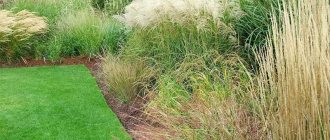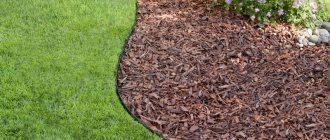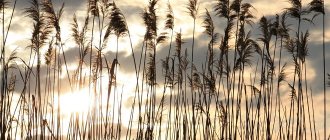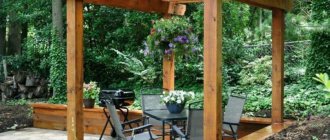Colored decorative wood chips are used to create bright accents in the garden. Wood mulch is made from natural wood with the addition of acrylic pigments. The material differs in its size and shape.
The main advantage of this design is its low cost and availability. Specialized stores offer a large selection of products. Wood chips help get rid of unwanted vegetation and add bright accents to the soil cover.
Features and useful properties of decorative material
Chips are a type of backfill used for landscaping. Many gardeners and designers have fallen in love with this particular material. Why?
This type of filling is harmless; for its production, only natural wood and dyes, which contain only organic substances, are selected.
Thanks to high-quality processing and modern technological processes, the pieces of material are not sharp, in a word, they are safe, so you will not get hurt during work.
Decorative wood chips are a designer's dream. It is made in a completely different color palette. The gamma is bright for a long time and resistant to natural phenomena.
Easy maintenance during use. If the backfill is laid out correctly, it will last about 5 years. It is not afraid of rain, is always clean, and easily copes with humidity.
Decorative wood chips protect the soil from erosion, creating good living conditions for worms.
The most important advantage of wood chips is that it is used as mulch. It conserves moisture, prevents the soil from drying out and overheating, protecting the roots of plants and trees. Where mulch is used, there are several times fewer weeds, and the soil underneath is loose.
Wood chips feed the roots with useful substances, because when the bottom layer rots, microelements are absorbed into the soil. Therefore, wood chips are used not only for decoration and for mulching, protecting and improving soil properties.
What kind of wood chips are used?
The process of producing high-quality wood chips goes through complex technological stages. First, the raw materials are cleaned, then crushed to sizes of 3–5 mm. After this, the wood chips are sifted through a special device and treated with antiseptic agents against fungi and harmful insects.
At the final stage, many manufacturers paint the raw materials in different shades, which gives a lot of scope for design imagination. Chips are made from different types of trees.
Did you know? The wood chips contain organic substances and mineral compounds, in particular 49% carbon, 44% oxygen and 7% hydrogen.
The following material is most often used in gardening:
- pine chips - ideal for decorating areas where coniferous plants grow. It will not only become an excellent decoration, but will also nourish the soil with the elements necessary for evergreen crops;
- oak chip — the material has a high density, which makes it a good insulator for the winter;
- larch bark - in comparison with pine, it is more expensive, as, in fact, is the wood itself;
- spruce chip — has a pleasant pine aroma, and its natural color is darker than that of pine bark;
- cedar bark - the densest and warmest material.
Laying woodchip mulch
When choosing a decorative material, pay attention to the size; it is usually indicated on the packaging. The filling should also be soft and moist. Laying wood chips is easy; start the process in late spring or early fall.
If you are going to make a pattern of different colors, then the area needs to be marked in advance. Remove debris, branches and leaves from the soil, and then loosen it and you can add fertilizer and don’t forget to water. It is best to lay mulch in sunny weather.
The layer of material can be more than 5 cm, depending on where it will be, in the shade or in the sun. When laying, leave a gap near the main stem so as not to disturb air circulation.
Chips can be laid out on open soil; to save on material, you can use agrofibre, which can slow down the growth of weeds.
Process of making wood mulch
To produce this material, wooden waste in the form of large sawdust and chips is used. Thanks to this, it is possible to avoid waste during the processing of solid wood. As a result, this technology is considered cost-effective in all respects.
Deciduous trees are used as the main material. They do not emit a specific odor during operation. First of all, large elements are crushed in special equipment. It separates wood scraps into neat chips.
After this, the collizer sprays the required pigment over the entire surface of the wood mulch. Next, the material is left until completely dry. The final stage will be packaging the products in plastic bags.
Landscape design and decorative wood chips
The use of decorative wood chips in landscape design is quite a popular process. A few words about colorless wood material. In most cases, such colorless chips are used to cover the soil. For example, they protect the roots of bushes and trees or lay them out between the rows in the garden where strawberries and other crops grow.
New Year's crafts from pine cones: decor ideas from pine cones for the New YearDecorative elements made of stone as an integral part of landscape design
Smartphone case: overview of the main types
Although this type of wood chips does not have a decorative function, a mulched garden looks much neater, which indicates caring owners. To implement different design solutions, you need to choose wood chips in contrasting shades.
Where are wood chips used?
More than 10 years ago, sawdust and wood chips were used to mulch the soil. Recently, this type of material has been used as decoration. Thanks to bright colors, landscape design acquires a peculiar zest and originality.
Where are wood chips used? There are several options where you can use wooden decor. These include:
- flower beds of annuals. This technique allows you to delimit the area of the site by type of plant;
- garden and jogging paths. This solution allows you to reduce the risk of injury while running or moving around the garden plot;
- arrangement of children's playgrounds. Decorating a play area for young children using such material helps prevent injuries and abrasions;
- local areas.
Decorative wood chips are considered the best option for filling in landscape design. It decorates and protects the soil cover from natural disasters.
Decoration of flower beds and flower beds
Colored decorative wood chips will help highlight the beauty of plants. You can simply lay out the material with a monochrome background or create a pattern, complementing the composition of the flower garden.
Green fill is suitable for simulating a lawn. Laying colored mulch under your trees will not only protect the roots, but also create a unique look in your garden.
How can you paint wood chips?
There are a lot of options for painting tree bark. All of them can be divided into two main categories: natural dyes and non-natural ones. Each of them has its own advantages and disadvantages.
Did you know? Wood chips are a filler for durable building materials
-
wood concrete, which is used to form large-sized masonry.
Natural components are well used for coloring mulch used for fruit crops . It does not pollute the site and does not interfere with the process of converting fertilizer into humus. The disadvantage is that the color will not be bright, and the paint will last no longer than three seasons. Natural dyes include: lime, brilliant green, potassium permanganate, beet juice, onion shell decoction, as well as watercolors and gouache.
To make painted wood chips look expressive and retain color for a long time, artificial dyes are used that retain the color for up to 20 years. But you need to take into account that such means can make mulch dangerous for the garden. Non-natural dyes include acrylic and water-based paints.
Decorative wood chips for a gardener can be a profitable solution for decorating a site, combining low cost and attractive appearance. These sawdust, which you can also make yourself, will protect plants from the negative influences of the environment and will serve as a beautiful material for decorating your home area.
Arrangement of children's and sports grounds
Decorative wood chips for playgrounds are a universal material, thanks to which mothers can forget about earth and grass stains on their children's pants. Wood waste is absolutely safe for children's health, and also allows you to create bright compositions due to its color variety. That is why decorative wood chips are often used to improve playgrounds.
In addition, such a coating ensures the safety of the child - he will not be able to scratch his leg by accidentally falling, or pick up some nasty stuff. The process of making the decorative coating uses double grinding and grinding, which means that children can play even barefoot without getting a splinter.
Laying features
To ensure that the consumption of decorative chips during installation is minimal, and the design is clear and beautiful, you must follow the correct algorithm of actions.
The installation sequence is as follows:
- weed out the weeds in the selected area;
- loosen the soil;
- fertilize with organic or complex compounds;
- water;
- make markings of the proposed drawing;
- put limiters according to the shape of the picture (you can use thick cardboard);
- you can make a layer between the soil and wood chips from agro-fabric;
- lay out the wood chips in a layer of no more than 5 cm in the compartments; in the shade, 2 cm will be enough, and you need to step back from the plant by 1-2 cm;
- level with a rake;
- remove the limiters, without trying to fill the resulting gap (it is necessary for additional drainage).
To preserve the bright color of decorative wood chips for a long time, it is advisable to use rainwater irrigation systems when watering beds and flower beds. A strong stream from a hose can not only quickly wash away paint (especially natural paint), but also destroy the integrity of the design.
How to make decorative mulch with your own hands
If you want to decorate your garden area beautifully and cheaply using decorative colored wood chips, you can quite easily make such material with your own hands. The simplest and easiest option to get ready-made, but not painted wood chips is to go to a sawmill or wood products factory for the material. Among other things, there are now a large number of special shredders and crushers for processing wood waste on sale.
It should be noted that the cost of such devices is quite high, so you can make the device yourself. The structure in this case should be represented by a frame, an engine, a shaft with cutting elements, a receiving compartment and a protective casing.
Manufacturing process
To give a highly decorative appearance, completely finished wood chips must be dyed. For this purpose, it is recommended to use aqueous solutions with the addition of color and stain. The wood material is carefully placed in specially prepared containers filled with dyes. In order for the coloring process to proceed as evenly as possible, it is very important to constantly stir the coloring solution.
If doubts arise about the quality or safety of ready-made chemical coloring compositions, then it is permissible to use readily available means for this purpose. An ordinary solution of pharmaceutical brilliant green allows you to obtain mulching material with a bright green color. Using onion peels, you can give wood natural brown shades of varying degrees of intensity, and a solution of potassium permanganate or beet broth can produce mulch in different shades of pink and purple.
Rubber mulch
Rubber chips are a universal material for design. It has advantages: it retains moisture for a long time, prevents its evaporation, and protects the soil from the appearance of weeds and various diseases. And such decorative woodchips are much cheaper than other types of mulch. Rubber crumbs are used to decorate flower beds of various types.
Production technology and advantages of wood mulch
The process of mulching a garden area with your own hands will not take much time and will not require special skills. You just have to purchase a sufficient amount of consumables. Wood mulch for the garden has a number of undeniable advantages:
- preventing the appearance and active development of weeds;
- decorating garden space or flower beds at a summer cottage;
- creating a favorable microclimate in the upper soil layers for the growth and development of cultivated plants;
- ensuring moisture conservation and drainage;
- protection of the soil from erosional changes and accumulation of heavy metal salts falling along with precipitation;
- maintaining sufficient ventilation of soil layers;
- ensuring a comfortable temperature regime for the root system of plants;
- protection of roots from freezing and overheating;
- protection of garden plants and vegetable gardens from pathogenic microflora and pests.
Decorative wood chips can have not only natural shades, but can also be painted in a variety of colors. Wood chips can be represented by unpainted bark of coniferous trees, often used as a simple but very effective decorative covering, as well as shredded chips of deciduous trees. For the production of wood mulch, coniferous wood species such as Siberian larch and Siberian cedar, as well as Angara pine, are most often used.
The equipment performs primary processing in the form of crushing raw materials on a chipper, after which a special machine cleans and sifts wood chips. Then grinding to the required size and careful secondary sifting are carried out. The result of two-stage processing is the production of high-quality and homogeneous raw materials, which are painted in the desired shades with a “colorizer”.
The painted material has a uniform color and rich shades, has sufficient resistance to aggressive environmental influences, is able to maintain the richness of the color for two or three seasons, and at the end of use it naturally decomposes and turns into a very useful organic fertilizer.
The use of decorative gravel in the garden
Gravel is a certain type of mulch that is used for laying paths in the park, finishing flower beds, etc. In particular, gravel is in demand when designing rock gardens. Natural material can be completely different in shades, sizes and textures. And besides this, gravel has the following advantages: the wind does not carry it from place to place, the material protects the area from the germination of weeds and retains heat for a long time.











